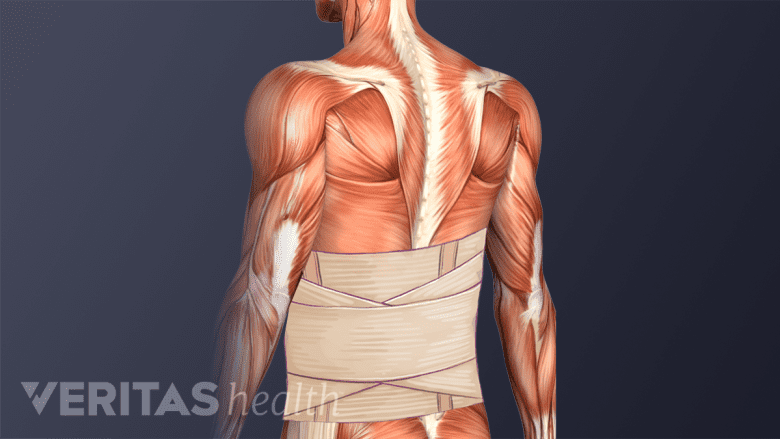The treatment for foot drop varies and is focused on managing the underlying cause. Typically, foot drop resolves or decreases once the underlying condition is treated. Both nonsurgical and/or surgical treatments may be used.
In This Article:
Foot Drop Treatment for Spinal Causes
Nonsurgical and surgical treatments for foot drop due to lower back conditions are discussed below.
Herniated disc
Foot drop from a bulging or herniated disc may be treated with one or more of the following:
- Pain-relieving medications
- Physical therapy
- Fluoroscopically guided epidural steroid injections
In severe herniation, the disc may need to be surgically removed to take the pressure off the nerve.
Watch Lumbar Herniated Disc Treatment Video
Spinal Stenosis
A lumbar epidural steroid injection reduces inflammation and pain due to spinal stenosis.
Foot drop treatment from compression of spinal nerves within the small bony openings includes one or more of the following:
- Anti-inflammatory medications like ibuprofen or aspirin
- Physical therapy
- Activity modification
- Epidural injections
See Lumbar Spinal Stenosis Treatment
In severe compression from bone spurs (abnormal bony growths), decompression surgery might be performed.
See Lumbar Laminectomy Surgery for Spinal Stenosis (Open Decompression)
Spondylolisthesis

A lumbar brace improves spinal stability and reduces spondylolisthesis pain.
Foot drop due to compression of spinal nerve roots when a vertebra slips over the adjacent vertebra below it may be treated with:
- Physical therapy
- Epidural steroid injections
- Lumbar stabilizing brace
Spinal fusion surgery may be required in severe spondylolisthesis.
Vertebral Fractures
Foot drop due to fracture of the vertebrae and nerve damage may be treated with medication and a lumbar brace. Sometimes, minimally invasive procedures such as vertebroplasty or kyphoplasty may be performed, where bone cement is injected to stabilize and reform the fractured vertebra.
Foot Drop Treatment for Peroneal Neuropathy
Treatment typically depends on the type of trauma to the peroneal nerve. A few examples include1Stewart JD. Foot drop: where, why and what to do? Practical Neurology. 2008;8(3):158-169. doi:10.1136/jnnp.2008.149393:
- Foot and ankle brace to aid in walking and prevent tripping
- Physical therapy to strengthen the muscles of the leg and foot
Surgery may be recommended in the treatment of laceration injuries, acute compartment syndrome, and tumors. Surgery may include nerve repair, nerve grafting, or tendon grafts.1Stewart JD. Foot drop: where, why and what to do? Practical Neurology. 2008;8(3):158-169. doi:10.1136/jnnp.2008.149393
Foot Drop Treatment for Central Causes
Foot drop due to brain and/or spinal cord conditions such as stroke or cerebral palsy may be treated with2Ho C, Adcock L. Foot Drop Stimulators for Foot Drop: A Review of Clinical, Cost-Effectiveness, and Guidelines [Internet]. Ottawa (ON): Canadian Agency for Drugs and Technologies in Health; 2018 Nov 21.Available from: https://www.ncbi.nlm.nih.gov/books/NBK537874/:
- Foot and ankle brace
- Physical therapy
- Functional electrical stimulators (FES)
The electric stimulators help treat foot drop by applying small electrical currents to the peripheral nerves through electrodes that are controlled wirelessly by in-shoe sensors.2Ho C, Adcock L. Foot Drop Stimulators for Foot Drop: A Review of Clinical, Cost-Effectiveness, and Guidelines [Internet]. Ottawa (ON): Canadian Agency for Drugs and Technologies in Health; 2018 Nov 21.Available from: https://www.ncbi.nlm.nih.gov/books/NBK537874/ Sometimes, surgery may be required.
Foot drop may cause mild to severe disability and may be associated with pain and other symptoms. the underlying causes are usually localized to the lower back and/or leg, sometimes serious medical conditions such a brain tumor may cause a dropped foot. The long-term outlook is generally favorable and depends on the severity and type of the cause. If a foot drop is suspected, it is advised to consult a medical professional immediately for prompt treatment.
- 1 Stewart JD. Foot drop: where, why and what to do? Practical Neurology. 2008;8(3):158-169. doi:10.1136/jnnp.2008.149393
- 2 Ho C, Adcock L. Foot Drop Stimulators for Foot Drop: A Review of Clinical, Cost-Effectiveness, and Guidelines [Internet]. Ottawa (ON): Canadian Agency for Drugs and Technologies in Health; 2018 Nov 21.Available from: https://www.ncbi.nlm.nih.gov/books/NBK537874/

